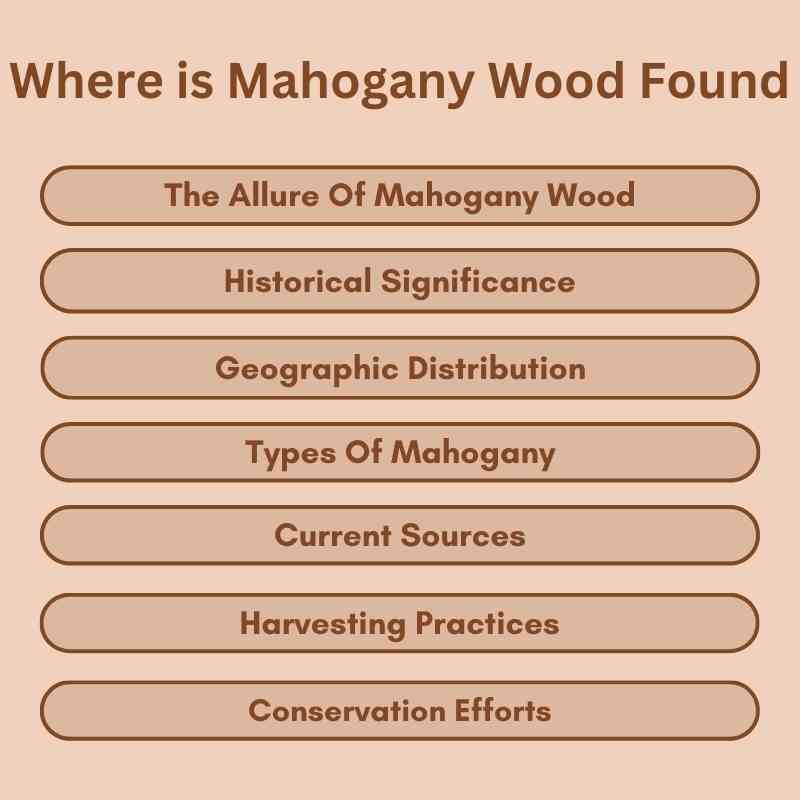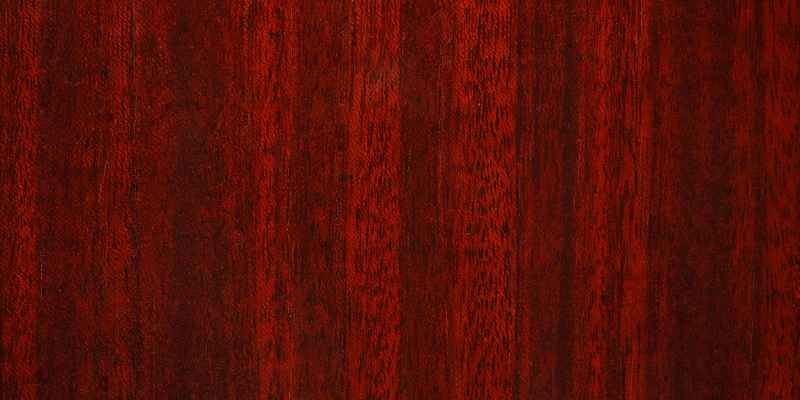Mahogany wood is primarily found in tropical regions, especially in Central and South America, as well as parts of Africa and the Caribbean. Countries like Honduras, Brazil, and Belize are significant sources of this prized timber.
Mahogany is renowned for its rich color and durability, making it a favorite for furniture and cabinetry. This hardwood comes from several species of trees, notably Swietenia macrophylla. Its fine grain and resistance to decay make it highly sought after.
The beauty and longevity of mahogany wood contribute to its popularity in both traditional and modern designs. Sustainable sourcing is crucial, as overharvesting threatens its availability. Understanding where mahogany is found helps consumers make informed choices about their wood products.
The Allure Of Mahogany Wood
Mahogany wood is a treasure in the world of furniture. Its deep color and smooth texture attract many. People love it for its beauty and durability. This wood is more than just material; it symbolizes luxury and elegance.
A Symbol Of Luxury
Mahogany has a rich history. It has been used in fine furniture for centuries. Here are some reasons why it stands out:
- Rich Color: The deep reddish-brown hue adds warmth.
- Fine Grain: Its straight grain gives a polished look.
- Longevity: Mahogany lasts for generations.
- Versatility: It fits in any style, from classic to modern.
High-end brands often use mahogany in their products. It is a go-to choice for luxury yachts and musical instruments. Its appeal is undeniable in high-quality furniture.
Unique Properties
Mahogany boasts unique properties that set it apart:
| Property | Description |
|---|---|
| Density: | Mahogany is dense, making it strong. |
| Workability: | It is easy to carve and shape. |
| Resistance: | It resists decay and insects. |
| Finish: | It takes stain and polish beautifully. |
These properties make mahogany a favorite among craftsmen. It is perfect for creating stunning pieces that last. Mahogany wood is truly a masterpiece in any home.
Historical Significance
Mahogany wood holds a rich historical significance. It has shaped cultures and economies over centuries. Its unique properties make it a prized material.
Early Use And Trade
Mahogany trees grow in Central and South America. Indigenous people first used the wood for tools and structures. They recognized its strength and beauty early on.
During the 16th century, European explorers discovered mahogany. They admired its dark color and durability. This led to increased trade. Mahogany became popular in Europe for furniture and shipbuilding.
| Year | Event |
|---|---|
| 1500s | Discovery by European explorers |
| 1600s | Export to Europe begins |
| 1700s | Popularity in furniture making |
Cultural Impact
Mahogany’s influence stretches beyond trade. It symbolizes status and craftsmanship. Many cultures use mahogany in traditional art and ceremonies.
- Furniture making
- Musical instruments
- Crafts and artifacts
In some cultures, mahogany is sacred. It represents strength and resilience. The wood connects generations through its use and beauty.
Geographic Distribution
Mahogany wood is highly sought after for its beauty and durability. Understanding where it grows helps in conservation and responsible sourcing.
Tropical Rainforests
Mahogany trees thrive in tropical rainforests. These forests are rich in biodiversity and provide the perfect climate for growth. Here are some key features:
- High humidity levels
- Consistent rainfall throughout the year
- Warm temperatures, usually between 20°C to 30°C
These conditions allow mahogany to grow tall and strong. The trees can reach heights of over 150 feet. Their wide trunks provide excellent quality wood.
Specific Regions
Mahogany is primarily found in specific regions across the world. Here’s a table showcasing these areas:
| Region | Country |
|---|---|
| Central America | Belize, Honduras, Guatemala |
| South America | Brazil, Peru, Colombia |
| Caribbean | Cuba, Dominican Republic |
These regions have the right environment for mahogany trees. They are often found near rivers and in lowland areas. Conservation efforts focus on protecting these unique ecosystems.
Mahogany’s geographic distribution is shrinking. Deforestation and illegal logging threaten its growth. Awareness and responsible practices are crucial for its survival.
Types Of Mahogany
Mahogany wood is famous for its beauty and durability. Many people use it in furniture and cabinetry. There are different types of mahogany. Understanding these types helps in choosing the right wood for your needs.
True Mahogany Species
True mahogany comes from the Swietenia genus. There are three main species:
- Swietenia macrophylla – Also known as Honduras mahogany. It has a reddish-brown color and is popular for furniture.
- Swietenia mahagoni – Known as Cuban mahogany. It is darker and has a fine grain.
- Swietenia humilis – Also called Pacific mahogany. It is less common and often used for smaller projects.
| Species | Common Name | Characteristics |
|---|---|---|
| Swietenia macrophylla | Honduras Mahogany | Reddish-brown, durable, easy to work with |
| Swietenia mahagoni | Cuban Mahogany | Darker, fine grain, highly sought after |
| Swietenia humilis | Pacific Mahogany | Less common, used for small projects |
Mahogany-like Woods
Some woods resemble mahogany but are not true mahogany. These woods often offer similar looks at lower prices. Here are a few:
- Khaya – Known as African mahogany. It has a similar grain and is more affordable.
- Sapele – A popular choice for furniture. It has a golden-brown hue.
- Meranti – Often used in construction. It is lighter and less expensive.
Choosing the right type of mahogany or mahogany-like wood is essential. Consider your budget and project needs. Each type has its own unique features.
Current Sources
Mahogany wood is highly sought after for its beauty and durability. Understanding where it comes from helps appreciate its value. Let’s explore the current sources of mahogany wood.
Major Exporting Countries
Several countries are known for their mahogany production. These nations play a key role in the global market.
| Country | Export Volume (Cubic Meters) |
|---|---|
| Brazil | 30,000 |
| Peru | 25,000 |
| Mexico | 15,000 |
| Colombia | 10,000 |
Brazil is the largest exporter. Peru and Mexico also contribute significantly. These countries provide high-quality mahogany.
Sustainability Practices
Responsible sourcing of mahogany is crucial for its future. Sustainable practices ensure forests are protected.
- Selective logging reduces environmental impact.
- Reforestation efforts help replenish mahogany stocks.
- Certification programs promote responsible harvesting.
Many companies focus on sustainable practices. They ensure the mahogany used is eco-friendly. This benefits both the environment and consumers.
Harvesting Practices
Harvesting practices for mahogany wood vary significantly. Traditional methods focus on sustainability. Modern techniques enhance efficiency and reduce waste. Understanding these practices is crucial for protecting our forests.
Traditional Methods
Traditional methods of harvesting mahogany wood rely on local knowledge. These methods often include:
- Selective Cutting: Only mature trees are cut down.
- Hand Tools: Workers use axes and saws.
- Minimal Impact: Care is taken to protect the surrounding environment.
This approach promotes the growth of young trees. It helps maintain biodiversity in forests.
Modern Forestry Techniques
Modern forestry techniques use advanced technology. These practices aim for efficiency and sustainability. Key methods include:
- Clear-Cutting: Removing all trees in an area.
- Controlled Logging: Using machinery for precision cutting.
- Reforestation: Planting new trees after harvesting.
These methods reduce waste and improve productivity. They also support forest regeneration. Many companies now follow strict guidelines. This helps balance economic needs with environmental protection.
| Method | Advantages | Disadvantages |
|---|---|---|
| Selective Cutting | Preserves ecosystem | Slower process |
| Clear-Cutting | Maximizes timber yield | Destroys habitats |
| Controlled Logging | Reduces waste | Requires heavy machinery |
| Reforestation | Restores forests | Time-consuming |
Understanding these harvesting practices helps us make informed choices. Sustainable practices protect mahogany for future generations.
Conservation Efforts
Mahogany wood is highly valued but endangered. To protect this resource, various conservation efforts are in place. These efforts aim to balance usage and preservation. Awareness is key to ensuring its survival.
Cites Regulations
The Convention on International Trade in Endangered Species (CITES) plays a crucial role. It regulates the trade of mahogany wood. Key points include:
- Appendix II Listing: This includes species that may become threatened.
- Permits Required: Export and import require specific permits.
- Monitoring Trade: Regular assessments help track mahogany usage.
CITES aims to ensure that trade does not harm the species. Countries must adhere to these regulations.
Community Forestry Initiatives
Local communities are vital in protecting mahogany. Community forestry initiatives empower locals to manage resources. Benefits include:
- Job Creation: Locals gain employment and income.
- Resource Management: Communities learn sustainable practices.
- Conservation Awareness: Education programs promote protection efforts.
These initiatives help restore mahogany populations. They also encourage responsible consumption. Together, communities work towards a sustainable future.
Future Of Mahogany
The future of mahogany wood is uncertain. Demand remains high. However, threats to its forests are serious. Sustainable practices are crucial for its survival.
Threats To Mahogany Forests
Several factors threaten mahogany forests. These include:
- Deforestation: Logging and land clearing harm habitats.
- Illegal Logging: Unregulated cutting leads to loss of trees.
- Climate Change: Altered weather patterns affect growth.
- Urbanization: Expansion of cities reduces forest areas.
These threats endanger mahogany’s future. Conservation efforts are essential to protect remaining forests.
Innovation In Sustainable Sourcing
Innovations in sustainable sourcing are vital for mahogany. Solutions include:
- Plantation Grown Mahogany: Farms grow mahogany trees for wood.
- Certification Programs: Organizations verify sustainable logging practices.
- Reforestation Projects: Planting new trees restores lost forests.
- Eco-friendly Products: Promoting alternatives reduces demand for wild mahogany.
These methods help ensure a future for mahogany. Protecting forests is a shared responsibility.

Frequently Asked Questions
Where Does Mahogany Wood Originate?
Mahogany wood primarily originates from tropical regions. The most common species are found in Central America, South America, and parts of the Caribbean. Countries like Honduras and Brazil are notable for their mahogany forests. These regions provide the ideal climate and soil conditions for mahogany growth.
What Are The Main Types Of Mahogany Wood?
The main types of mahogany wood include Honduran, African, and Philippine mahogany. Each type has unique characteristics and uses. Honduran mahogany is prized for its rich color and durability. African mahogany is known for its lighter weight and affordability, while Philippine mahogany is popular in furniture making.
Is Mahogany Wood Sustainable?
Sustainability of mahogany wood depends on harvesting practices. Responsible management and certification programs are essential for sustainability. Some mahogany species are endangered due to overharvesting. Always look for sustainably sourced mahogany, certified by organizations like the Forest Stewardship Council (FSC).
What Is Mahogany Wood Used For?
Mahogany wood is widely used in furniture, cabinetry, and flooring. Its beautiful grain and rich color make it a favorite among artisans. Additionally, it is used in musical instruments and boat building due to its durability. The versatility of mahogany wood makes it highly sought after.
Conclusion
Mahogany wood is a valuable resource found in various regions worldwide. From the Caribbean to Central and South America, its rich colors and durability make it highly sought after. Understanding where mahogany originates can help consumers make informed choices. Supporting sustainable practices ensures this beautiful wood remains available for future generations.

